 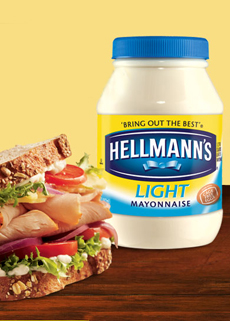
One of the more than five varieties of Hellmann’s Mayonnaise. Photo courtesy Best Foods.
KAREN HOCHMAN is Editorial Director of THE NIBBLE.
|
August 2010
Last Updated June 2021
|
 |
Hellmann’s & Mayonnaise History
Page 2: The Birth Of Modern Mayonnaise & The Launch Of Hellmann’s Mayonnaise
This is Page 2 of a two-page article on the history of mayonnaise, including the launch of the first commercial product, Hellmann’s Mayonnaise. Click on the black links below to visit Page 1.
Marie-Antoine Carême Reinvents Mayonnaise
Marie-Antoine Carême (1784-1833), known as the founder of the concept of haute cuisine, also bestowed his enormous gifts on the evolution of mayonnaise.
Years after its debut as a sauce, Carême lightened the original mayonnaise recipe by blending the vegetable oil and egg yolks into an emulsion. It was his recipe that became famous throughout Europe, and subsequently, the United States.
Then, having created a masterful sauce, he went on to devise the system of mother sauces that is fundamental to classic French cooking; as well as choux pastry, the hot soufflé and many other indispensable, including the chef’s toque. He is known as The King of Chefs and the Chef of Kings,” as he worked for Napoleon, the Rothschilds, Tallyrand and Tsar Alexander, among others.
|
|
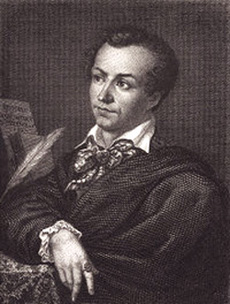
The great French chef Marie-Antoine Carême created the mayonnaise we know today. Image courtesy Wikimedia.
|
Like most prepared food, mayonnaise was a product made at home, as well as available at commercial enterprises such as shops and restaurants.
The American Master Of Mayonnaise
Packaged, commercial mayonnaise was first sold in 1905, in New York City.
Richard Hellmann (1876-1971) who immigrated from Vetschau, Germany (south of Berlin) in 1903, married the daughter of a delicatessen owner. He opened his own delicatessen on the Upper West Side, at 490 Columbus Avenue between 83rd and 84th Streets.
Some say it was Hellmann’s own recipe; other stories say that it was made by his wife* (who may have, in fact, made it using her husband’s recipe). Whoever originated it, the mayonnaise, used in salads and on sandwiches at the deli, became so popular that he began to sell it as a separate product, and then in bulk to other stores.
There were two versions of the recipe, packed in wooden “boats” that were used to weigh butter. A blue ribbon around one of the styles differentiated the two. The “blue ribbon” variety sold much better, so Hellmann designed a “Blue Ribbon” label and packaged that product in larger glass jars.
|
|
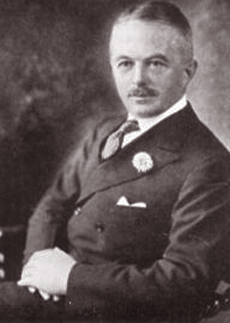
Richard Hellmann, whose recipe is the foundation for a great American brand. Photo courtesy Vetschau.de. |
Sales of Hellmann’s Blue Ribbon Mayonnaise were so good that Richard Hellmann started a distribution business, purchased a fleet of trucks and, in 1912, built a manufacturing plant. Business was so good that he sold the delicatessen by 1915, to devote his full time to the mayonnaise business.
He opened a small mayonnaise factory at 120 Lawrence Street (now West 126th Street). By the end of this year he had a much larger factory in Long Island City.
In 1916, the company was incorporated as Richard Hellman, Inc. Hellman tried making other products, including horseradish and pumpernickel bread; but decided to keep his focus on the booming mayonnaise business.
At about the same time, in California, Best Foods (now Best Foods) introduced an equally popular mayonnaise. The business, born as American Linseed Company in the 1800s, began to diversify in 1917, acquiring the Nucoa Butter Company, whose largest subsidiary, The Best Foods, Inc., produced margarine, mayonnaise, and other edible-oil products.
In 1932, Best Foods bought the Hellmann’s brand and decided to keep both brand names. To this day, Best Foods Mayonnaise is sold west of the Rocky Mountains and Hellmann’s is sold east of the Rocky Mountains. The two brands account for approximately 45% of all bottled mayonnaise sold in the U.S.
And mayonnaise has branched out.
Hellmann’s alone is available in Real Mayonnaise (the modern Blue Ribbon mayo), Light Mayonnaise, Canola Cholesterol Free Mayonnaise, Mayonnaise Dressing With Extra Virgin Olive Oil, Low Fat Mayonnaise Dressing and international editions such as Mayonesa con Jugo de Limón.
The same varieties are also available under the Best Foods brand.
Options in other brands include
organic mayonnaise, bacon mayonnaise, chipotle mayonnaise, lemon and herb mayonnaise and wasabi mayonnaise, among others.
|
|
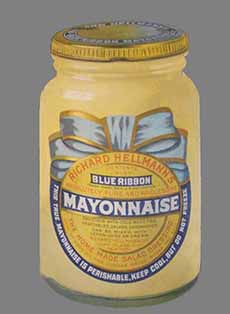
An illustration of the Blue Ribbon jar from 1926.
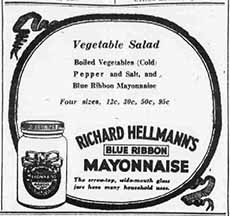
An add from 1922 provides a simple recipe for cold vegetable salad, and advises that the screw-top glass jars have “many household uses” (photo Wikipedia).
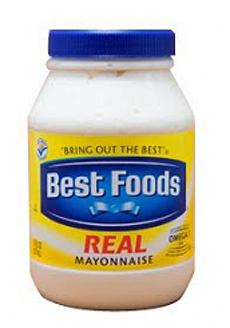
Best Foods purchased Hellmann’s in 1932 (photo © Best Foods).
|
______________
*Wikipedia credits the invention to Hellmann’s first wife, Margaret, who was also of German descent. His second wife, Nina, was much younger, born 1901 and of English descent. According to information sent by Brett and Leanne Jones, was half his age when they married. Richard and Margaret are noted on the 1910 Federal Census as living on Columbus Avenue in Manhattan.
Aïoli: Mediterranean Mayonnaise
The components of mayonnaise are oil, egg yolk, salt and lemon juice. A related sauce is aïoli (eye-YO-lee—the French word for garlic is ail, pronounced “eye”), a simpler emulsion of olive oil and garlic. It is very popular in the Provence region of France, where it is believed to have originated.
Traditionally, the garlic is ground with a mortar while adding small amounts of olive oil, which creates an emulsion. It is served as a sauce for a variety of dishes, from appetizers to main courses.
More modern aïoli recipes add egg yolks and Dijon mustard. This is not the “classic” aïoli, but it creates a very garlicky mayonnaise. You can make it or buy it. We recommend the aïoli from LuLu, a NIBBLE Top Pick Of The Week.
Make Your Own Mayonnaise
For the freshest flavor, make mayonnaise at home, just like Antoine Carême and Nina Hellmann did.
Mayonnaise can be hand-beaten (a.k.a. whisked, the original way), made with an electric beater or in an electric blender.
See Julia Childs’ Mayonnaise Recipe |
|
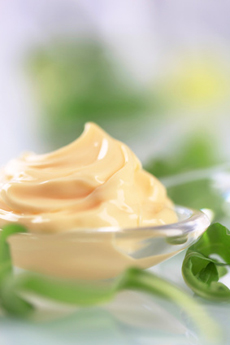
Homemade mayonnaise is a treat. Photo © Viktor | Fotolia. |
Recipes © copyright their respective owners. Additional material
Lifestyle Direct, Inc. All rights reserved.

|








